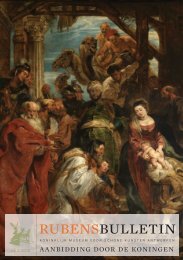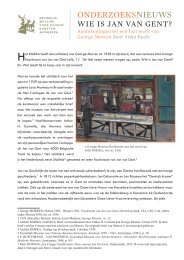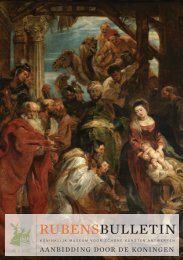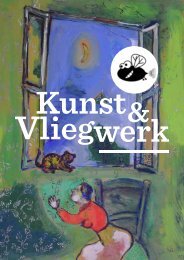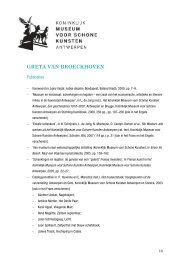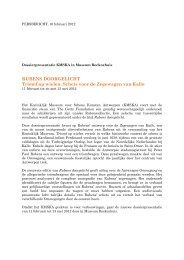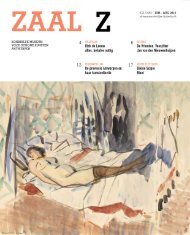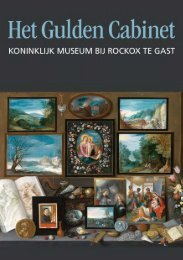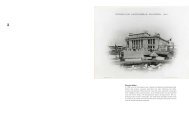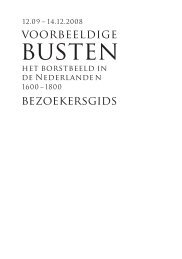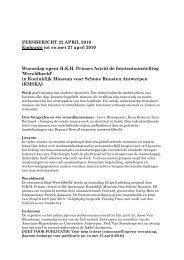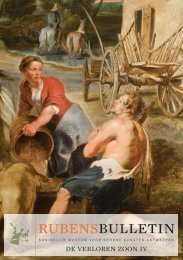visitors' guide to the presentation (PDF, 341 kB) - Koninklijk Museum ...
visitors' guide to the presentation (PDF, 341 kB) - Koninklijk Museum ...
visitors' guide to the presentation (PDF, 341 kB) - Koninklijk Museum ...
Create successful ePaper yourself
Turn your PDF publications into a flip-book with our unique Google optimized e-Paper software.
Antiquity, Roman conquerors were hailed during <strong>the</strong>ir triumphal<br />
processions.<br />
Guiding <strong>the</strong> chariot is Providentia Augusta, who is identified by <strong>the</strong><br />
inscription next <strong>to</strong> her head. Providentia stands for Providence or<br />
Foresight and Augusta refers <strong>to</strong> <strong>the</strong> Roman emperor Augustus. She<br />
symbolizes <strong>the</strong> foresight of <strong>the</strong> Spanish king and wears a laurel wreath<br />
as a symbol of vic<strong>to</strong>ry; fur<strong>the</strong>rmore, she is depicted with two faces,<br />
one looking forward <strong>to</strong> <strong>the</strong> future and <strong>the</strong> o<strong>the</strong>r looking back <strong>to</strong> <strong>the</strong><br />
past. She is modelled on Prudentia (Prudence or Wisdom), one of <strong>the</strong><br />
Cardinal Virtues. On <strong>the</strong> ground beside her is a flaming grenade.<br />
Behind her, on a raised platform, kneel Antverpia and Audomarum,<br />
<strong>the</strong> city maidens of Antwerp and St. Omer; <strong>the</strong>ir names appear in <strong>the</strong><br />
inscriptions above <strong>the</strong>ir heads. Both wear a crown in <strong>the</strong> form of<br />
turreted city walls. Antverpia’s crown is decorated with a wreath of<br />
roses and she is dressed in <strong>the</strong> city colours of Antwerp, red and white.<br />
Audomarum, wearing a yellow cloak, rests her hand on a heraldic<br />
shield. The stance and gestures of <strong>the</strong> city maidens appear <strong>to</strong> express<br />
<strong>the</strong>ir joy at <strong>the</strong> vic<strong>to</strong>ry gained.<br />
The personifications of Virtus (Virtue, as well as Valour and Resolve)<br />
and Fortuna (Fortune, as well as Coincidence or Luck) stand at <strong>the</strong><br />
stern of <strong>the</strong> ship. They, <strong>to</strong>o, are connected <strong>to</strong> <strong>the</strong> triumph: Virtus, symbolising<br />
military power and wearing a helmet, is holding a sword and<br />
a thunderbolt; Fortuna is <strong>the</strong> symbol of fortune, of fickle luck that is<br />
sometimes with one and sometimes against, just as <strong>the</strong> wind that<br />
puffs up her garment. With her hand resting on a ship’s rudder, she<br />
likewise represents safe passage. At <strong>the</strong> foot of <strong>the</strong> trophy are three<br />
seated prisoners of war, who represent <strong>the</strong> Hollanders and French<br />
taken prisoner after <strong>the</strong> vic<strong>to</strong>ries at Kallo and St. Omer.<br />
The triumphal chariot is decorated with fes<strong>to</strong>ons and swirling decorations<br />
that end in lobe-like motifs. Sea creatures, such as <strong>the</strong> dolphin<br />
with a put<strong>to</strong> astride its back and <strong>the</strong> tri<strong>to</strong>n blowing his conch shell,<br />
ride <strong>the</strong> waves and appear <strong>to</strong> be guiding <strong>the</strong> ship; <strong>the</strong> reference is <strong>to</strong> <strong>the</strong><br />
(24)




